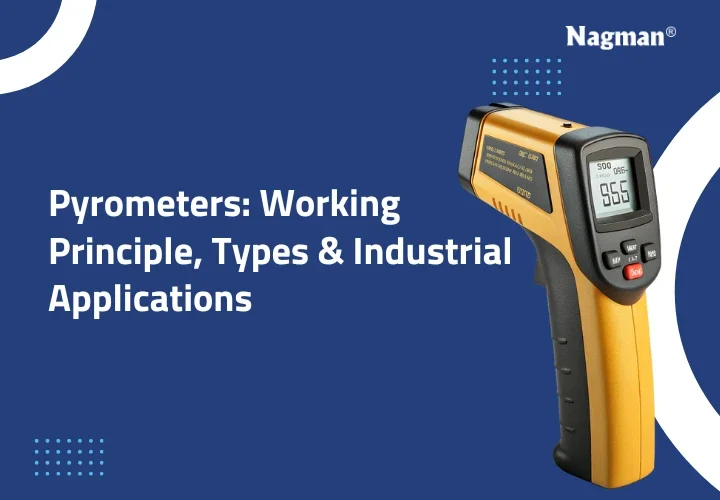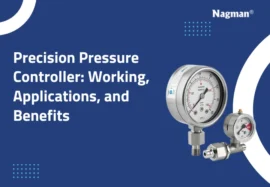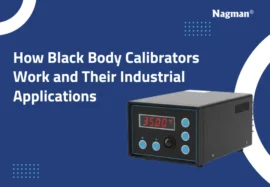Introduction
Industrial pyrometers are non-contact temperature measuring instruments used to detect infrared radiation from high-temperature surfaces and convert it into accurate readings. These devices are essential in environments where traditional contact sensors such as thermocouples and RTDs fail due to extreme heat, fast-moving surfaces, or safety limitations. Industrial pyrometers provide safe, reliable, and precise temperature monitoring for critical operations across various sectors including metal processing, glass manufacturing, cement kilns, ceramics, and power generation.
By enabling high-temperature measurements without direct contact, industrial pyrometers significantly reduce risk for operators while helping maintain product quality and operational efficiency. Their fast response time and long-term durability make them one of the most trusted instruments in modern industrial temperature monitoring.
How Industrial Pyrometers Work
Industrial pyrometers function on the principle that every object above absolute zero emits infrared radiation. These devices use optical sensors to capture the emitted energy and advanced algorithms to convert it into accurate temperature readings. The biggest advantage is that measurement happens from a safe distance, eliminating the need for physical contact with hot surfaces.
Advantages of non-contact measurement
Eliminates sensor damage from heat exposure
Allows safe temperature monitoring
Provides instant readings for dynamic processes
Works efficiently even with smoke, dust, or limited visibility
Unlike contact sensors that wear down due to high heat or vibration, industrial pyrometers offer longer operational life with minimal maintenance.
Types of Industrial Pyrometers
Several types of industrial pyrometers are used based on application and environmental conditions:
1. Optical Pyrometers
Used for extremely high temperatures by comparing color intensity. Ideal in molten metal inspection and furnace supervision.
2. Infrared Pyrometers
The most commonly used type. Suitable for fast and precise non-contact measurements across different industries.
3. Radiation Pyrometers
Measure total emitted radiation and are typically used in glass melting, metal smelting, and kiln operations.
4. Ratio Pyrometers
Function effectively even with obstructions like smoke or dust. Ideal for harsh environments.
Choosing the right type depends on temperature range, materials involved, visibility conditions, and required response rate.
Industrial Applications
Metal Processing
Industrial pyrometers monitor furnace temperatures and molten metal conditions to prevent defects and ensure consistent material strength.
Glass Manufacturing
They help maintain accurate furnace temperature, improving clarity, uniformity, and structural performance of glass products.
Cement and Ceramics
Used to control kiln temperature precisely, reducing energy waste and improving product durability.
Power Plants
Industrial pyrometers measure boiler and turbine temperatures, enhancing safety and operational efficiency.
Food Processing
Enable hygienic, non-contact monitoring in cooking and sterilization operations without contaminating goods.
Key Benefits of Industrial Pyrometers
High safety due to non-contact design
Fast and precise readings
Continuous temperature monitoring reduces operational interruption
Enhances quality control
Integrates with automation and smart industrial systems
Comparison with Contact Temperature Devices
| Feature | Industrial Pyrometers | Thermocouples / RTDs |
|---|---|---|
| Contact Requirement | No | Yes |
| High-Heat Resistance | Excellent | Limited |
| Accuracy | High | Moderate |
| Maintenance | Low | Frequent |
Contact-based sensors are suitable for moderate conditions, while industrial pyrometers perform best in high-temperature or fast-moving applications.
Calibration and Integration
Like all precision instruments, industrial pyrometers require routine calibration to ensure accuracy. Calibration involves comparing temperature readings with a known reference standard and adjusting the instrument if necessary.
They are often calibrated using dry block temperature calibrators and integrated with other equipment such as digital pressure indicators, pressure gauge calibration systems, and process calibrators for comprehensive monitoring.
Proper calibration:
Maintains long-term accuracy
Ensures compliance with ISO 17025 and safety guidelines
Minimizes calibration drift and measurement errors
For reference, industries often follow guidelines such as
https://www.iso.org/standard/66912.html (link with follow attribute recommended)
Choosing the Right Industrial Pyrometer
Important factors to consider:
Target temperature range
Environmental challenges (dust, heat, moisture)
Response time required
Whether handheld or fixed-installed unit is needed
Compatibility with SCADA, PLC, or monitoring systems
Future of Industrial Pyrometers
With the rise of smart manufacturing, industrial pyrometers are evolving into intelligent, connected monitoring tools.
Upcoming innovations:
IoT-based remote tracking
AI predictive analytics to detect performance anomalies
Wireless connectivity for real-time reporting
Integration with cloud-based automation systems
These advancements support Industry 4.0 transformation and predictive process management.
Conclusion
Industrial pyrometers have become a vital temperature measurement solution for high-heat industrial environments. Their non-contact design, accuracy, and fast response make them indispensable where conventional temperature sensors fail. By integrating industrial pyrometers with monitoring systems such as digital pressure indicators and process calibrators, industries can achieve enhanced control, operational efficiency, and safety.
With ongoing advancements in AI and IoT technologies, industrial pyrometers are transforming into smart, predictive instruments and will continue playing a critical role in future manufacturing automation.






